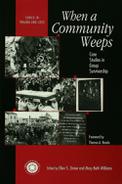Humanmade and Natural Disasters
Disasters that occur by dint of human miscalculation or through violent acts of nature can be traumatic for many reasons. In four of the five chapters included in this section of the book—the Challenger explosion, the sinking of the ferry Estonia, a dual bus crash in Australia, and the earthquakes in Armenia and in Japan—loss of life was extensive. Countless numbers of individuals suffered severe injury and physical harm. Survivors and rescuers alike were exposed to death, perilous conditions, and grotesque scenes. Events were unexpected. While predisaster training was in place prior to some of these disasters, no one was prepared for the specific crisis that occurred, and no one had clear control over the outcome. In Kobe, Japan, for example, massive dislocation and relocation accompanied widespread destruction of property and contributed to the enormous breadth of the disaster. Yet cultural norms and mores prevented outward expression of grief, led to rejection of outside help, and delayed the onset of crisis intervention.
In Chapter 2, Ellen Zinner, a certified grief therapist and death educator and college administrator at the University of Baltimore, in Baltimore, Maryland, describes the events of January 26, 1986, that are burned into the memory of millions of children and adults who were watching the explosion of the Challenger Space Shuttle on television from their homes and schools. In contrast to the Armenian and Great Hanshin earthquakes described in later chapters, loss of life was relatively small. Yet the event became a nodal loss for many in the United States. The shared sense of national mourning was facilitated by wide television coverage and immediate political response. How that loss and subsequent bereavement were expressed and resolved is the central point of her chapter. An important focus is the role of initial and even decade-later memorializations, including the creation of the Challenger Centers for Space Science Education. This chapter also addresses the various aggregates of individuals who composed survivor groups in the wake of the Challenger loss.
Lassi Nurmi, Senior Lecturer at the Finnish Police Academy in Espoo, Finland, and psychologist on the Disaster Victim Identification Team, describes in Chapter 3 the sudden sinking of the HMS Estonia in September 1994, and the frantic attempts to rescue hypothermic survivors in rough seas. A major focus is the response of national disaster teams and effectiveness of later critical incident stress debriefings. The impact of the sinking of the ferry on Finland as a nation, on rescuers, and on the author himself was extensive. No longer was ferry travel seen to be free from danger. Rescuers who did not receive debriefing (such as the nurses at Turku Hospital) appeared to suffer more than others. Nurmi himself changed his philosophy of life and lost his ability to believe in a nondisappointing God. The chapter concludes with the lessons learned from this rescue effort.
Rod Watts and Marise Wilson, both involved with their local Community Health Team in Australia, chronicle in Chapter 4 the response of community rescuers to a holiday bus crash near Kempsey, New South Wales, Australia. After the collision of two coaches in late December, 1989, over 360 persons responded in some fashion to the disaster. Assessment results of State Emergency Service workers at 1, 3, and 12 months postaccident demonstrate the emotional repercussions that interventions efforts can have even upon trained professionals. Over 50% of the workers who responded to the accident were moderately negatively affected even a year later. The chapter also describes the changes that occurred both to the town of Kempsey and to the emergency service teams following this nationally significant event.
In Chapter 5, Dr. Anie Kalayjian, a noted traumatologist and logo-therapy psychotherapist in New York, describes the community response to the Armenian earthquake of December 7, 1988. The quake, measuring 6.9 on the Richter scale, left 500,000 children orphaned and over 500,000 homeless. In contrast to the Kobe earthquake which occurred 7 years later, goods, food, and services quickly poured into Armenia from various governments around the world. Kalayjian describes the nation’s and citizenry’s responses to the earthquake in light of the culture and history of Armenia. She also looks in detail at psychosocial responses during the acute and chronic phases of this immense disaster.
The final chapter in this section speaks to the Great Hanshin (Kobe) earthquake and the culturally based responses (and lack of responses) to that disaster. Initially, this chapter was written by Dr. Tom Williams. However, when he was unable to finish it, Dr. G. Robert Baker came to the “rescue” to try his turn at relating the events that occurred following the massive destruction of Kobe. He, too, found that vicarious traumatization takes its toll, and the task of completing the chapter passed to their colleague, coeditor Mary Beth Williams. Writing about a disaster that has left such a personal toll on those who witnessed the aftermath was a powerful experience, even at a distance. The chapter attempts to do justice to the contributions of the two original authors and the work that they did in training the Japanese in critical incident responses and in implementing Dr. Baker’s innovative “bearapy.”
